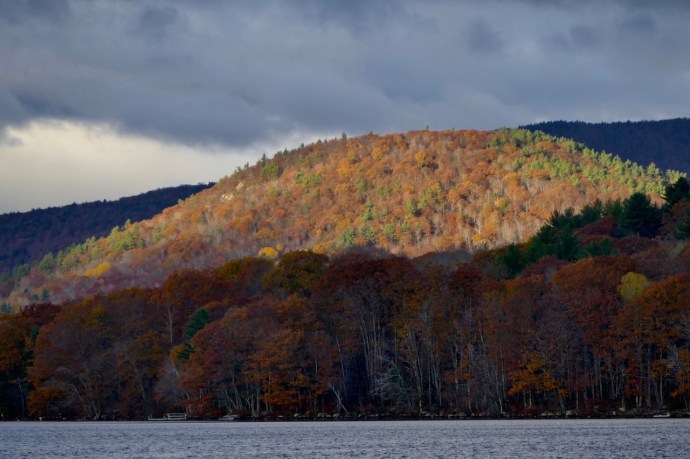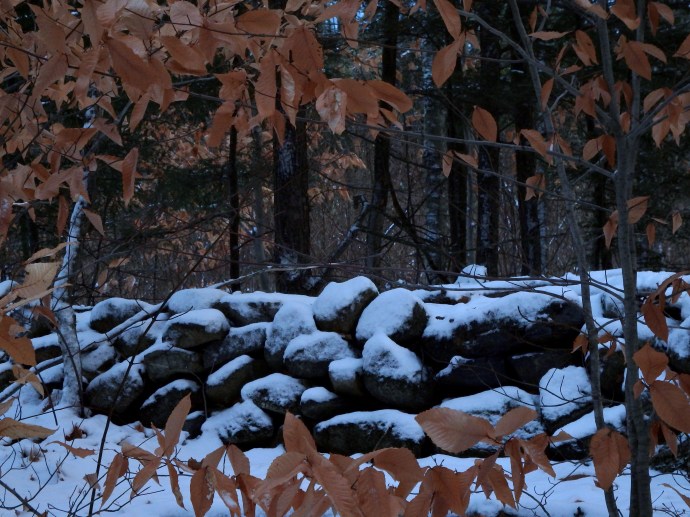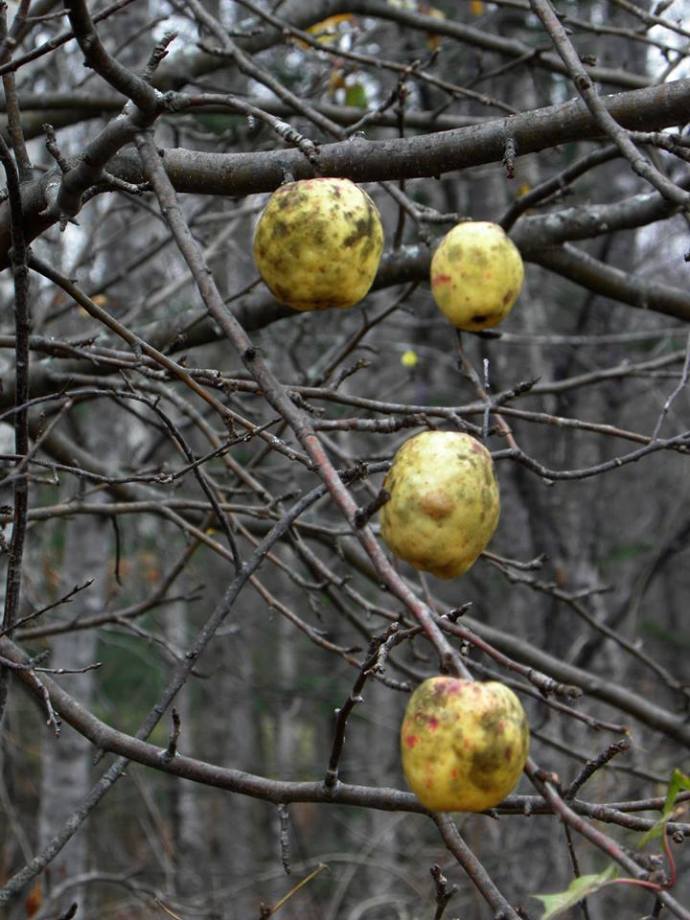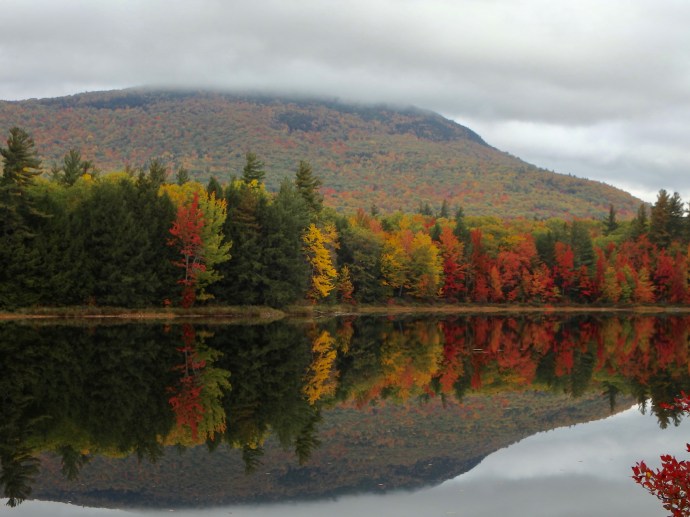in Thoreau’s Journal:

Is not this already November when the yellow & scarlet tints are gone from the forest?

in Thoreau’s Journal:

Is not this already November when the yellow & scarlet tints are gone from the forest?
in Thoreau’s Journal:
What with the rains & frosts & winds the leaves have fairly fallen now— You may say the fall has ended. Those which still hang on the trees are withered & dry — I am surprised at the change since last Sunday — Looking at the distant woods I perceive that there is no yellow nor scarlet there now— They are (except the evergreens) a mere dull dry red— The autumnal tints are gone. What life remains is merely at the foot of the leafstalk. The woods have for the most part acquired their winter aspect— And coarse rustling light colored withered grasses skirt the river & the woodside— This is November— The landscape prepared for winter without snow— When the forest & fields put on their sober winter hue. We begin to look more to the sunset for color & variety.

Now now is the time to look at the buds the swamp pink—some yellowish, some mixed with thin oblong seed-vessels red—&c. The larger red maple buds have now 2 sets of scales—3 in each. The water Andromeda is still green— Along the Depot Brook the great heads of A. Puniceus stand dry & fuzzy & singularly white (—like the golden rods & other asters—) but some quite low are still green & in flower
The prevalence of this light dry Color perhaps characterizes November—that of whitening withered grass—of the fuzzy gray goldenrods—harmonizing with the cold sunlight—and that of the leaves which still hang on deciduous trees.
in Thoreau’s Journal:
I know of no such amusement, –– so wholesome and in every sense profitable, ––for instance, as to spend an hour or two in a day picking some berries or other fruits which will be food for the winter, or collecting driftwood from the river for fuel, or cultivating the few beans or potatoes which I want.

Theatres and operas, which intoxicate for a season, are as nothing compared to these pursuits.
in Thoreau’s Journal:
Tell me precisely the value and significance of these transient gleams which come sometimes at the end of the day, before the close of the storm, final dispersion of the clouds, too late to be of any service to the works of man for the day, and notwithstanding the whole night after may be overcast!

Is not this a language to be heard and understood? There is, in the brown and gray earth and rocks, and the withered leaves and bare twigs at this season, a purity more correspondent to the light itself than summer offers.
in Thoreau’s Journal:

The colors of the fields make haste to harmonize with the snowy mantle which is soon to invest them and with the cool, white twilights of that season which is itself the twilight of the year.
in Thoreau’s Journal:
This is the season of the fall when the leaves are whirled through the air like flocks of birds, the season of birch spangles,

when you see afar a few clear-yellow leaves left on the tops of the birches.
in Thoreau’s Journal:

The autumnal tints grow gradually darker & duller— They are doing to a crisp. But not less rich to my eye — And now a hill side near the river exhibits the darkest crispy reds and browns of every hue all agreeably blended— At the foot next the meadow stands a front rank of smoke like maples bare of leaves—intermixed with yellow birches. Higher up red oaks of various shades of dull red—with yellowish perhaps black oaks intermixed—and walnuts now brown—& near the hill top or rising above the rest perhaps a still yellowed oak—& here and there amid the rest or in the fore ground on the meadow—dull ashy salmon-colored white oaks large & small—all these contrasting with the clear liquid sempiternal green of pines.
in Thoreau’s Journal:

The larches in the swamps are now conspicuously yellow & ready for their fall.

Small yellow apples hanging over the road.
in Thoreau’s Journal:
This may be called an Ind. summer day. It is quite hazy withal & the mts invisible. I see a hore-hound turned lake or steel claret color. The yel lily pads in Hubbards ditch are fresh as if recently expanded. There are some white lily pads in river still—but very few indeed of the yel. lily. A pasture thistle on Conantum just budded but flat with the ground. The fields generally wear a russet hue. A striped snake out. The milk weed (Syriaca) now rapidly discounting.

The lanceolate pods having opened the seeds spring out on the least jar or when dried by the sun—& form a little fluctuating white silky mass or tuft each held by the extremities of the fine threads, until a stronger puff of wind sets them free. It is a pleasant sight to see it dispersing its seeds…
in Thoreau’s Journal:
To Walden
Ebby Hubbards oaks now turned a sober & warm red & yellow have a very rich crisped & curled took—especially against the green pines— This is when the ripe high colored leaves have begun to curl & wither—then they have a warm & harmonious tint. First they are ripened by the progress of the year & the character of each appears in distinct colors. Then come the severe frosts & dulling the brilliancy of most—produces a harmony of warm brown—or red & yellow tinges through out the forest.— Something like marbling & paining over it—making one shade run into another. The forest is more rug-like…

In consequence of the above winds—& clouds—we have tonight a bright warm sunset (to me on the water) after a cool gray afternoon—lighting up the green pines at the NE end of the pond—every yellow leaf of birch or aspen or hickory is doubly bright—& looking over the forest on Pine Hill I can hardly tell which trees are lit up by the sun-shine and which are the yellow chestnut tops. Thus both the spring & autumn tints or aspect of the woods reminds me of the sunshine. The first has never so good a setting and foreground as seen from the middle of a lake rising from the water’s edge— The waters edge makes the best frame for the picture & natural boundary to the forest.

in Thoreau’s Journal:
This is a remarkable feature in the landscape now—the abundance of dead weeds. The frosts have done it. Winter comes on gradually. The red maples have lost their leaves before the rock maple which is now losing its leaves at top first.

All the country over the frosts have come & sered the tenderer herbs along all brook sides— How unobserved this change until it has taken place.
in Thoreau’s Journal:
Green leaves are doubtless handsome in their season, but now that we behold these ripe ones, we are inclined to think that the former are handsome somewhat as green fruits are, as green apples and melons….

At this season each leaf becomes a laboratory in which the fairest and brightest colors are compounded.
in Thoreau’s Journal:
At this season of the year, when each leaf acquires its peculiar color, Nature prints this history distinctly, as it were an illuminated edition. Every oak and hickory and birch and aspen sprinkled amid the pines tells its tale a mile off, and you have not to go laboriously through the wood examining the bark and leaves.

These facts would be best illustrated by colors, ––green, yellow, red, etc.
1858 in Thoreau’s Journal:
A village is not complete unless it has these trees to make the season in it. They are as important as a town clock. Such a village will not be found to work well. It has a screw loose; an essential part is wanting. Let us have willows for spring, elms for summer, maples and walnuts and tupelos for autumn, evergreens for winter, and oaks for all seasons.

1859 in Thoreau’s Journal:
Why can we not oftener refresh one another with original thoughts? If the fragrance of the dicksonia fern is so grateful and suggestive to us, how much more refreshing and encouraging – re-creating – would be fresh and fragrant thoughts communicated to us fresh from a man’s experience and life! I want none of his pity, nor sympathy, in the common sense, but that he should emit and communicate to me his essential fragrance, that he should not be forever repenting and going to church (when not otherwise sinning), but, as it were, going a-huckleberrying in the fields of thought, and enrich all the world with his visions and his joys.
in Thoreau’s Journal:

Methinks the reflections are never purer and more distinct than now at the season of the fall of the leaf, just before the cool twilight has come, when the air has a finer grain. Just as our mental reflections are more distinct at this season of the year, when the evenings grow cool and lengthen and our winter evenings with their brighter fires may, be said to begin. And painted ducks, too, often come and sail or float amid the painted leaves.
in Thoreau’s Journal:

It is the more remarkable at this season because the oak is all red and yellow and the pine all green. I understand it and read its history easily before I get to it.
in Thoreau’s Journal:

The first snow is falling (after not very cool weather) in large flakes filling the air & obscuring the distant woods & houses….


in Thoreau’s Journal:
The Pond is now most beautifully framed with the autumn tinted woods & hills—

….How peaceful great nature—there is no disturbing sound…
1851 in Thoreau’s Journal:

I seem to be more constantly merged in nature; my intellectual life is more obedient to nature than formerly, but perchance less obedient to spirit. I have less memorable seasons.
1852 in Thoreau’s Journal:

What an ample share of the light of heaven each pond & lake on the surface of the globe enjoys— No woods are so dark & deep but it is light above the pond. Its window or skylight is as broad as its surface. It lies out patent to the sky. From the mt top you may not be able to see out because of the woods—but on the lake you are bathed in light.
You must be logged in to post a comment.